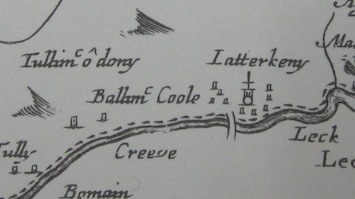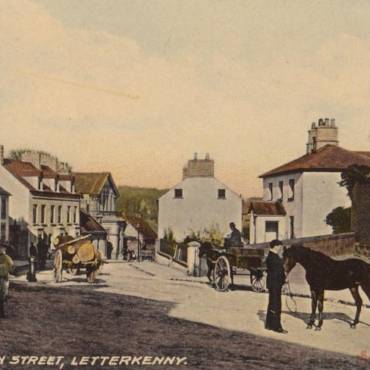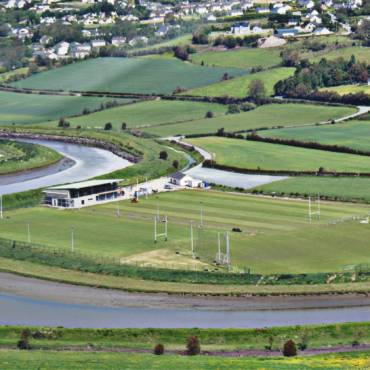The Origins of Kirkstown
The townland of Kirkstown lies to the northwest of the town of Letterkenny today, situated above Ballymacool, and is accessed by a road opposite the O’Donnell Park. Growing up in the town, many people (myself included), were led to believe that the townland got its name from the old Scottish name for a Presbyterian church – a ‘kirk’ –that supposedly stood somewhere in this area. As Glencar Scotch sits next to the townland, that possibility was not inconceivable. However, after extensive research, there is no evidence that any church was ever located in this area. So how then could Kirkstown have got its name?
Looking at the sign that leads to the townland today, we can see that the Gaeilge for Kirkstown is Baile McGiolla Choirce. Importantly, the use of the ‘McGiolla’ in the name would suggest that the area was in fact named after a person – as in McGiolla Bhríghde or McGiolla Easpaig etc.
Looking at maps from 1655 and 1685, we can see that the area of land next to Ballymacool was originally named Tullymcadony (or Tullymcdonnell, possibly meaning the Hill of McDonnell), a townland that no longer exists. Therefore we must surmise from this that the name of Tullymcadony was changed to Kirkstown sometime after 1685. Putting all of this together, it would appear that Kirkstown is named after Major General Percy Kirke (1646-91), a significant character in the Williamite Wars.
Born around 1646, the son of George Kirke, Percy was a professional soldier very well connected at court. He served his military apprenticeship in the Army of Louis XIV during the 1670s and from 1681 – 1683 he was the governor of Tangier in Morocco. He fought at the Battle of Sedgemoor in 1685 and was a leading figure in the conspiracy in the Army that brought William of Orange to the throne. He commanded the relief of Derry, breaking the Jacobite’s army relentless Siege of 1689.
In July of 1689, James FitzJames, the Duke of Berwick and illegitimate son of James II marched his infantry to Letterkenny and from there to Ramelton where they encountered the Williamite forces. Having been repulsed from the town, the Duke retreated and attempted to destroy the town of Letterkenny on his return, only for it to be saved by the actions of Captain Henry Hunter, a man under the command of Major General Percy Kirke.
For services during the Williamite Wars, many families were rewarded with land – the Stewart family were granted land at Gortlee where they built their estate for example. Therefore it would not be surprising that Captain Henry Hunter could have been granted land at Tullymcadony for his actions in saving the town from being destroyed. He would then have called his new lands after the commander of the Williamite forces, Major General Percy Kirke and thus ‘Kirkstown’ was born.
We can never know for sure of course, but it would seem far more likely that the area gets its name from Major General Percy Kirke than from any Scottish church, especially owing to the predominance of the Hunter families in that area up until the present day.
As a footnote to that, tradition tells us that the area of Sentry Hill beside the St. Eunan’s College was named after lookouts or ‘sentries’ who kept watch for advancing Redcoats during Penal Times to warn the massgoers at the Mass Rock at Roger’s Burn. However, what if there was another possibility? As the Catholics at that time predominantly spoke Gaeilge, Mass Rocks were known as Carraig an Aifrinn. Why then is Sentry Hill not called Cnoc an nGarda or something equivalent? The word ‘sentry’ is quite a militaristic term, usually denoting a soldier keeping watch. Could this area have been used instead as a Sentry post to protect the town from attack such as Captain Hunter’s soldiers warning of the advances of the Duke of Berwick in 1689? That is not to say that the area was not also used by lookouts during Penal Times, merely that the English name of ‘Sentry Hill’ could derive from these attempts to protect the town from attack. Again, we’ll never know for sure, but as always with history, it is always interesting to question previously held beliefs.



